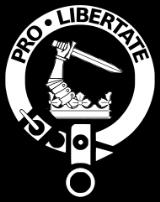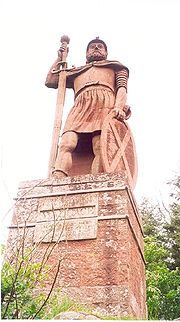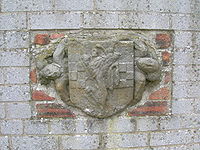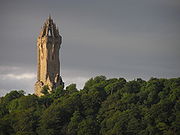
Clan Wallace
Encyclopedia
Origins of the clan
The Wallace family first came to Scotland with a NormanNormans
The Normans were the people who gave their name to Normandy, a region in northern France. They were descended from Norse Viking conquerors of the territory and the native population of Frankish and Gallo-Roman stock...
family in the 11th century. King David
David I of Scotland
David I or Dabíd mac Maíl Choluim was a 12th-century ruler who was Prince of the Cumbrians and later King of the Scots...
was eager to extend the benefits of Norman influence and gave grants to the nobles of the south. Among them was Walter Fitzallan, who the Scottish king appointed his Steward in 1136. One of Fitzallan's followers was Richard Wallace from Oswestry
Oswestry
Oswestry is a town and civil parish in Shropshire, England, close to the Welsh border. It is at the junction of the A5, A483, and A495 roads....
who came north to try and improve his fortunes. Oswestry is on the Welsh
Wales
Wales is a country that is part of the United Kingdom and the island of Great Britain, bordered by England to its east and the Atlantic Ocean and Irish Sea to its west. It has a population of three million, and a total area of 20,779 km²...
border so it is possible that the name Wallace may be a corruption of Le Waleis meaning the "Welshman".
Lord Fitzallan received from King David lands in Ayrshire and so it was here that his follower Richard Wallace settled. Richard Wallace was granted his own estate in Kyle, where it is claimed that his name Richard is still remembered in the placename of the village of Riccarton
Riccarton, Ayrshire
Riccarton is a village and parish in East Ayrshire, Scotland. It lies across the River Irvine from Kilmarnock. The river Irvine divides the parishes of Riccarton and Kilmarnock and the river used to form the boundary between the districts of Kyle and Cunninghame.- History :The village became a...
.

Fiona Watson
Fiona Watson was a Scottish political affairs officer working in Vieira de Mello's office who was killed along with other members of UN staff in the Canal Hotel bombing in Iraq, on the afternoon of 19 August 2003....
in "A Report into Sir William Wallace's connections with Ayrshire", published in March 1999, reassesses the early life of William Wallace and concludes, "Sir William Wallace was a younger son of Alan Wallace, a crown tenant in Ayrshire".The mother of William Wallace was Margaret Crawford (Crauford).
Wars of Scottish Independence
There is no evidence to support the tale that in his early years William Wallace and his mother had to take refuge near Dunipace from the English because they refused to pay homage to King Edward IEdward I of England
Edward I , also known as Edward Longshanks and the Hammer of the Scots, was King of England from 1272 to 1307. The first son of Henry III, Edward was involved early in the political intrigues of his father's reign, which included an outright rebellion by the English barons...
. While Wallace was still young he became the leader of a company of patriots who used harassing tactics against the English and won the support of many Scottish nobles. Wallace's military genius made him "hated and feared" by King Edward I of England.
During the Wars of Scottish Independence
Wars of Scottish Independence
The Wars of Scottish Independence were a series of military campaigns fought between the independent Kingdom of Scotland and the Kingdom of England in the late 13th and early 14th centuries....
William Wallace and Andrew de Moray won a great and stunning victory at the Battle of Stirling Bridge
Battle of Stirling Bridge
The Battle of Stirling Bridge was a battle of the First War of Scottish Independence. On 11 September 1297, the forces of Andrew Moray and William Wallace defeated the combined English forces of John de Warenne, 6th Earl of Surrey and Hugh de Cressingham near Stirling, on the River Forth.-The main...
in 1297. Wallace was also in command at the Battle of Falkirk (1298)
Battle of Falkirk (1298)
The Battle of Falkirk, which took place on 22 July 1298, was one of the major battles in the First War of Scottish Independence...
, but there he was defeated. Unfortunately for the Scots, Wallace was eventually captured at Robroyston
Robroyston
Robroyston is a northeastern suburb of the city of Glasgow, Scotland. It was where Scottish leader William Wallace was turned over to English soldiers in 1305. At the site of Wallace's capture there stands a monument — there have also been proposals put forward for a Visitors Centre in the area,...
near Glasgow
Glasgow
Glasgow is the largest city in Scotland and third most populous in the United Kingdom. The city is situated on the River Clyde in the country's west central lowlands...
and delivered to Edward Longshanks of England by a senior Scottish law officer - Sir John Mentieth. Wallace was subjected to a mock trial, in which he was found guilty of treason
Treason
In law, treason is the crime that covers some of the more extreme acts against one's sovereign or nation. Historically, treason also covered the murder of specific social superiors, such as the murder of a husband by his wife. Treason against the king was known as high treason and treason against a...
and brutally hanged, drawn, and quartered at Smithfield, London
Smithfield, London
Smithfield is an area of the City of London, in the ward of Farringdon Without. It is located in the north-west part of the City, and is mostly known for its centuries-old meat market, today the last surviving historical wholesale market in Central London...
in 1305.
.png)
Border wars
During the centuries that followed, the Wallace family continued to leave its marks, cultural and political, on Scotland and on Europe. In the 15th century, General John Wallace commanded Scotland's armies to victory over England at the Battle of SarkBattle of Sark
The Battle of Sark was fought between England and Scotland in October 1448. A large battle, it was the first significant Scottish victory over the English in over half a century, following the Battle of Otterburn of 1388...
. Among those who joined him were the forces of George Douglas from the powerful Douglas family.
17th century and civil war
The Wallaces of Cragie from who the senior branch of the clan is descended obtained their estate during the early 17th century, through the marriage to the heiress of Sir John Lindsay of Cragie.A contemporary Wallace, James Wallace served as a Captain under General Robert Monro when he occupied Huntly Castle
Huntly Castle
Huntly Castle is a ruined castle in Huntly in Aberdeenshire, Scotland. It was the ancestral home of the chief of Clan Gordon, Earl of Huntly.-History:...
of the Clan Gordon
Clan Gordon
Clan Gordon, also known as the House of Gordon, is a Scottish clan. The chief of the clan was the powerful Earl of Huntly, now also Marquess of Huntly.-Origins:...
in 1640. Another contemporary Wallace, Sir Hugh Wallace
Craigie Castle, Ayrshire
Craigie Castle in the old Barony of Craigie, is a ruined fortification situated about southeast of Kilmarnock and southeast of Craigie village, in the Parish of Craigie, South Ayrshire, Scotland....
, celebrated Cavalier, raised the regiment for King Charles Stuart
Charles I of England
Charles I was King of England, King of Scotland, and King of Ireland from 27 March 1625 until his execution in 1649. Charles engaged in a struggle for power with the Parliament of England, attempting to obtain royal revenue whilst Parliament sought to curb his Royal prerogative which Charles...
during the Puritan revolution of Oliver Cromwell
Oliver Cromwell
Oliver Cromwell was an English military and political leader who overthrew the English monarchy and temporarily turned England into a republican Commonwealth, and served as Lord Protector of England, Scotland, and Ireland....
.
In 1669 Hugh Wallace of Cragie was one of the Scottish nobility who was created a Baron of Nova Scotia under Sir William Alexander of Menstreis's scheme to promote that part of Canada
Canada
Canada is a North American country consisting of ten provinces and three territories. Located in the northern part of the continent, it extends from the Atlantic Ocean in the east to the Pacific Ocean in the west, and northward into the Arctic Ocean...
as a Scottish colony.
Also in the 17th century, mathematician John Wallis was the first to deal with the concept of infinity mathematically and paved the way for the development of calculus and binomial theorem
Binomial theorem
In elementary algebra, the binomial theorem describes the algebraic expansion of powers of a binomial. According to the theorem, it is possible to expand the power n into a sum involving terms of the form axbyc, where the exponents b and c are nonnegative integers with , and the coefficient a of...
in his 1657 work Arithmetica Infintorum.
Wallaces in the 19th century

Alfred Russel Wallace
Alfred Russel Wallace, OM, FRS was a British naturalist, explorer, geographer, anthropologist and biologist...
, developed his own theories on evolution, based on his studies of flora and fauna in South America
South America
South America is a continent situated in the Western Hemisphere, mostly in the Southern Hemisphere, with a relatively small portion in the Northern Hemisphere. The continent is also considered a subcontinent of the Americas. It is bordered on the west by the Pacific Ocean and on the north and east...
and in the East Indies
East Indies
East Indies is a term used by Europeans from the 16th century onwards to identify what is now known as Indian subcontinent or South Asia, Southeastern Asia, and the islands of Oceania, including the Malay Archipelago and the Philippines...
, independently of Charles Darwin
Charles Darwin
Charles Robert Darwin FRS was an English naturalist. He established that all species of life have descended over time from common ancestry, and proposed the scientific theory that this branching pattern of evolution resulted from a process that he called natural selection.He published his theory...
. Both theories were published simultaneously in 1858. Thomas Wallace served as the vice-president of the British Board of Trade, who in 1821, cut the duties long imposed on Baltic
Baltic region
The terms Baltic region, Baltic Rim countries, and Baltic Rim refer to slightly different combinations of countries in the general area surrounding the Baltic Sea.- Etymology :...
timber; the act herald the end of the mercantile system that had existed since England had first established colonies. Sociologist Graham Wallis was an early leader of the Fabian Society
Fabian Society
The Fabian Society is a British socialist movement, whose purpose is to advance the principles of democratic socialism via gradualist and reformist, rather than revolutionary, means. It is best known for its initial ground-breaking work beginning late in the 19th century and continuing up to World...
, along with George Bernard Shaw
George Bernard Shaw
George Bernard Shaw was an Irish playwright and a co-founder of the London School of Economics. Although his first profitable writing was music and literary criticism, in which capacity he wrote many highly articulate pieces of journalism, his main talent was for drama, and he wrote more than 60...
, an organization which promoted the peaceful and democratic "permeation of (British) politics with socialist and collectivist ideas." Sir Richard Wallace was a great collector of painting, sculpture and furniture; primarily 18th century French. He bequeathed his collections to the people of Britain; upon his death in 1897 they became known as the National Wallace Collection
Wallace Collection
The Wallace Collection is a museum in London, with a world-famous range of fine and decorative arts from the 15th to the 19th centuries with large holdings of French 18th-century paintings, furniture, arms & armour, porcelain and Old Master paintings arranged into 25 galleries.It was established in...
.

Memorial
At StirlingStirling
Stirling is a city and former ancient burgh in Scotland, and is at the heart of the wider Stirling council area. The city is clustered around a large fortress and medieval old-town beside the River Forth...
on top of the Abbey Craig
Abbey Craig
The Abbey Craig is the hill upon which the Wallace Monument stands, at Causewayhead, just to the north of Stirling, Scotland.The Abbey Craig is part of a complex quartz-dolerite intrusion or sill within carboniferous strata, at the western edge of the Central Coal Field, known as the Stirling Sill...
stands the nation's William Wallace Monument
Wallace Monument
The National Wallace Monument is a tower standing on the summit of Abbey Craig, a hilltop near Stirling in Scotland. It commemorates Sir William Wallace, the 13th century Scottish hero....
built in 1896. In 1814 a huge statue was erected to his memory near Dryburgh Abbey
Dryburgh Abbey
Dryburgh Abbey, near Dryburgh on the banks of the River Tweed in the Scottish Borders, was nominally founded on 10 November 1150 in an agreement between Hugh de Morville, Lord of Lauderdale and Constable of Scotland, and the Premonstratensian canons regular from Alnwick Abbey in Northumberland...
in the Scottish Borders
Scottish Borders
The Scottish Borders is one of 32 local government council areas of Scotland. It is bordered by Dumfries and Galloway in the west, South Lanarkshire and West Lothian in the north west, City of Edinburgh, East Lothian, Midlothian to the north; and the non-metropolitan counties of Northumberland...
. The Wallaces of Craigie, of Cessnock
Cessnock
Cessnock can refer to:*Cessnock, New South Wales** Electoral district of Cessnock, an electoral district in the New South Wales Legislative Assembly, based around the area** City of Cessnock, the Local Government Area...
, of Kelly and of Cairnhill are all descended from the original family of Riccarton
Riccarton, Ayrshire
Riccarton is a village and parish in East Ayrshire, Scotland. It lies across the River Irvine from Kilmarnock. The river Irvine divides the parishes of Riccarton and Kilmarnock and the river used to form the boundary between the districts of Kyle and Cunninghame.- History :The village became a...
in Ayrshire.
Septs
There are no septSept (social)
A sept is an English word for a division of a family, especially a division of a clan. The word might have its origin from Latin saeptum "enclosure, fold", or it can be an alteration of sect.The term is found in both Ireland and Scotland...
families of Clan Wallace, just Wallace. This is the decision of the current clan chief.
Some of the many ways of spelling the name attributed to the family of:
Most common Wallace - and second most common: Wallis
Walla, Wallais, Wallace, Wallice, Wallang, Wallass, Wallayis, Wallays, Walleis, Wallensis, Walles, Walleyis, Walleys, Walli, Wallis Walls, Wallyis, Wallys, Walois,Walys
- Waces, Wal’, Walace, Walais, Walans, Walas, Walays, Wale, Waleis, Walency, Walens, Walense, Walensen, Walensi, Walensis, Wales, Waless, Waleys, Waleyss
- Valance, Valensis, Valeyns, Vallace, Vallance, Valles, Valleyis, Vallibus (Not Vallibus, which has always signified the family of de Vaux or Vaus)
- Uallas (the Scots Gaelic)
- Gadhel, Galeis, Galeius, Gales, Galeys, Galleius, Grieve, Galleius, Galles, Galles, Gallia, Gallois, Gaul, Gweddol
Clan Profile
- Arms of the Chiefs: Gules, a Lion rampant argent, armed azure, a Bordure counter company azure and argent.
- Crest Badge: Issuant from a crest coronet of four (three visible) strawberry leaves Or, a dexter arm vambraced, the hand brandishing a sword all Proper.
- Natural Badge of water: A sprig of oak fructed Proper.
- Motto: Pro Libertate - "For liberty".
- Gaelic Name: Uallas
- Tartans: Red Wallace, Green Wallace, Blue Wallace; each available in modern, ancient and weathered hues and all invented in relatively recent times.
See also
- William WallaceWilliam WallaceSir William Wallace was a Scottish knight and landowner who became one of the main leaders during the Wars of Scottish Independence....
- Scottish clanScottish clanScottish clans , give a sense of identity and shared descent to people in Scotland and to their relations throughout the world, with a formal structure of Clan Chiefs recognised by the court of the Lord Lyon, King of Arms which acts as an authority concerning matters of heraldry and Coat of Arms...
- Craigie Castle, AyrshireCraigie Castle, AyrshireCraigie Castle in the old Barony of Craigie, is a ruined fortification situated about southeast of Kilmarnock and southeast of Craigie village, in the Parish of Craigie, South Ayrshire, Scotland....
- Wallace's Monument, AyrshireWallace's Monument, AyrshireWallace's Monument, the Wallace Tower, or the Barnweill Monument is a category-A-listed folly dedicated to the memory of William Wallace located on Barnweill Hill , a prominent location in the Parish of Craigie, South Ayrshire, Scotland.-Purpose and origins:The Wallace Monument is a picturesque...

